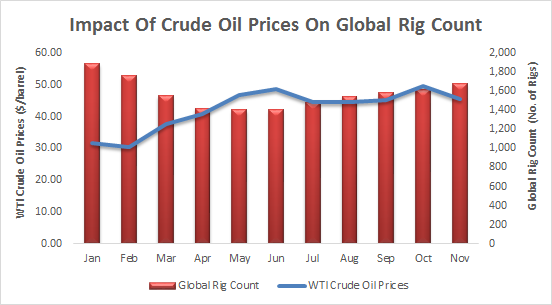Commodity markets have been on a roller roaster ride throughout 2016.
The year began on a disappointing note with crude oil prices plummeting
to multi-year lows of close to $25 per barrel due to the consistent
demand and supply mismatch of crude oil markets worldwide. As a result,
the markets witnessed a severe sell-off of oil and gas stocks, as the
investors became wary of the recovery in the industry. What followed was
a series of bankruptcies and poor financial results by some of the
largest oil and gas players in the US in the first quarter, painting a
gloomy picture for the year ahead. This forced most of the oil and gas
majors to curtail their exploration and drilling activities by cutting
back their capital expenditures drastically for the year. For instance, Petroleo Brasileiro Petrobras
reduced its capital spending budget for the next four years to $74.1
billion, as opposed to $98.4 billion previously decided by the company.
The lack of demand for drilling and exploration activities led to a
gradual, yet sharp, drop in the demand for rigs across the globe. This
was evident in the decline in the global oil and gas rig count in the
first half of 2016. The rig count, which stood at close to 1,900 units
in January, fell to roughly 1,400 units in May, representing a plunge of
more than 25% in just five months. This, further increased the anxiety
among investors, deteriorating the valuation of a majority of oil and
gas companies worldwide.

Source: US Energy Information Administration; Baker Hughes Rig Count
However, some of these companies managed to rebound in the subsequent
quarters as commodity markets showed initial signs of recovery. A
series of unforeseen and unexpected events occurred which caused
commodity prices, particularly crude oil prices, to recover steeply. The
unfortunate wildfire in Canada, along with economic instability in
Venezuela, and geo-political disturbances in Nigeria and Ghana, changed
the dynamics of the supply of oil, resulting in a sharp rise in oil
prices in the second quarter. This came as a relief to a lot of oil and
gas companies and their performance improved in the June quarter. But,
the fluctuations in the US oil inventory kept the companies on their
toes to sustain their performance and investors worried about the
stability of their investments.
However, with the softness in the oil markets creating pressure on
the finances of the Middle East countries, the Organization of Petroleum
Exporting Countries members decided to hold an unplanned meeting in
September to revisit their stance on their rising oil production. To
everyone’s surprise, the cartel announced its plans to put a ceiling of
their cumulative production to reverse the decline in oil prices. This
sent a wave of cheer across the industry, with a number of oil and gas
stocks recovering some portion of their lost valuation.
The final terms of the OPEC arrangement were announced on the 30th
November, where the members decided to reduce their cumulative oil
output by 1.2 million barrels of oil per day (Mbpd) over the coming
months. In addition to this, the Non-OPEC members, such as Russia, also
supported the OPEC’s move by offering to bring down their production by
roughly 600,000 barrels of oil per day. In response to the news, crude
oil prices have shot up by almost 20% over the last one month,
reinforcing to investors that the commodity markets are on the path of
recovery. In fact, in anticipation of this news, a few of the oil and
gas producers had increased their capital spending budget for 2016. For
instance, Anadarko Petroleum
upwardly revised its capital expenditure for the year from $2.7 billion
to $2.9 billion in the their third quarter results. Similarly, EOG Resources had hiked its capital spending budget from $2.5 billion to $2.7 billion in order to expand their operations.
While the trajectory of recovery of the commodity markets is still
uncertain, the optimistic outlook for the industry is likely to help
these companies mitigate their losses to a certain extent and recover
back their lost value in the coming quarter. Thus, despite the ups and
downs in the commodity markets, the year 2016 ended on a good note and
the oil and gas industry is entering 2017 on a strong note.
View Interactive Institutional Research (Powered by Trefis):
No comments:
Post a Comment